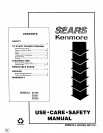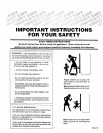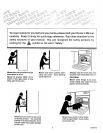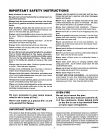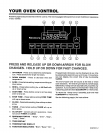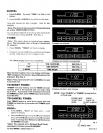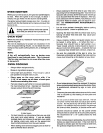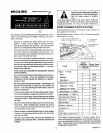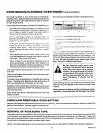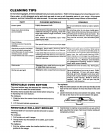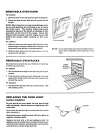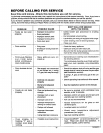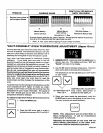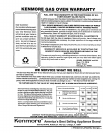
OVEN IGNITION
When you turn the oven on, the glow bar Igniter begins
to heat. When the Igniter is hot enough, in about 1
minute, the gas flows into the burner and is ignited.
The Igniter glows bright orange when hot. It cycles on
and off with the thermostat and will glow whenever the
burner Is on.
I_ During a power failure the burner cannot
be lit and you should not try to do so.
OVEN VENT
When the oven Is on, heated air moves through a vent
behind the grille.
The vent is necessary for proper air circulation in the
oven and good baking results. Do not block this vent.
Doing so may cause cooking failure, fire, or damage the
oven.
NOTE:
A fan will automatically turn on during oven
functions to cool internal parts. This is normal.
The fan may continue to run even after the oven
is turned off,
OVEN COOKING
Always follow recipe carefully.
Measure ingredients properly.
Use proper pan placement. Place longest side of
pan parallel to longest side of oven.
Place pans on the oven racks with t" to
1 1/2" of air space on all sides of each pan,
Avoid overcrowding the oven,
Pans too close to each other or to oven walls block
the free movement of air. Improper air movement
causes uneven browning and cooking.
2 cake layers
i
4 cake layers
For best results, we recommend that you use only
one oven rack when baking. If you are baking
multiple Items and choose to use both oven racks
for baking, place oven racks on the second and
fourth shelf positions from the oven bottom.
When baking several Items stagger pans so that no
pan is directly above another.
When cooking for the first time in your new oven,
use time given on recipes as a guide. Your new oven
has been set correctly at the factory and is more apt
to be accurate than the oven It replaced. After you
have used your oven for awhile, If you feel your oven
should be hotter or cooler, you can adjust it your-
self. See TEMPERATURE ADJUSTMENTS in
this manual.
Let the oven preheat thoroughly before cooking
baked products. Listen for preheat tone.
Opening the door too often to check food during
baking will allow heat loss and may cause poor
baking results.
Cakes, cookies, muffins, and quick breads should
be baked In shiny pans -- to reflect the heat --
because they should have a light golden crust.
Yeast breads and pie crusts should be baked in
glass or dull (non-shiny) pans -- to absorb the heat
-- because they should have a brown, crisp crust.
Be sure the underside of the pan is shiny too.
Darkened undersides will absorb the heat and may
cause over browning on the bottom of your food.
H "
Oven temperatures should be reduced 25 degrees
below recommended temperatures Ifexterior of pan
is predarkened, darkened by age or oven proof
glass.
There may be some odorwhen the oven is first used.
This is caused by the heating of new parts and
insulation.
Do not cover an entire oven rack with foil. The foil
can block normal heat flow and cause poor baking
results. Do not place any foil directly on the oven
bottom. Foil used on the oven bottom may damage
the oven surface; therefore, it should not be used.
Cookies should be baked on flat cookie sheets
without sides to allow the air to circulate properly.
We recommend 10" x 14" cookie sheets for best
results.
When recipes require preheating, have food nearby
before you open the oven door. If the oven door is
allowed to remain open for more than a brief time,
the preheat temperature will be lost.
NGOVCO2-2



